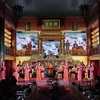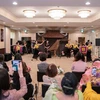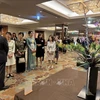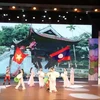Researchers have acknowledged the value and attraction to communities of “hat xoan” (ancestor worship singing), a tradition of Phu Tho province, and are considering applying to UNESCO for its recognition as an Intangible Culture Heritage, which needs urgent protection.
About 32 domestic and foreign researchers and folklore experts have gathered at a seminar in the mid-land province to share information on the art which, like any traditional or popular art form, has the benefits of being emotionally uplifting, which providing social cohesion for villagers.
Folk culture researcher Nguyen Khac Xuong introduced the concept of a " hat xoan culture area" spreading from Phu Tho to other localities as Duc Bac, Tu Du, Hoang Thuong and Huong Non.
“Hat xoan” had overwhelmed other folk ways of singing in the large deltas of Da, Hong and Ma rivers, he said. It had created a cultural area, which could be called " hat xoan cultural space".
Musicologist Tran Quang Hai, who chaired the seminar last weekend, said the new concept was worth consideration.
“Hat xoan” is believed to have originated more than 500 years ago. It is now popular in the villages of An Thai, Phu Duc, Kim Doi and Thet along the Lo River in Phu Tho. It is also popular in other localities in midland and northern regions.
It is somewhat similar to the lullaby. Like quan ho (love duets singing), many of the songs in “ hat xoan” are about love, but more traditionally it is a way of worshipping the village spirits, which are typically ancestors of residents. Some song lyrics are spoken and some are sung by a group, and they are often accompanied by dances.
“Hat xoan” festivals are often held in the spring in village temples.
Traditionally, a group of “ hat xoan” singers would stand at a temple gate, to be joined by singers from other villages who pair up with the host singers.
Host singers play the role of brothers and sisters while the guests act as juniors. According to local customs, once two singers are paired as brother and sister, they were not able to marry one another.
Today, “ hat xoan” is typically only performed on the fifth day of the first lunar month. The artists often gather and sing at the Hung Temple festival, dedicated to the Hung kings, who are the legendary ancestors of the Viet people.
Cultural researchers attending the seminar from France , Republic of Korea and Thailand suggested the unique way of singing should be introduced in schools as most young people did not know anything about the art.
They stressed that both central and local authorities should join the protection process, advertise the art to local residents in the area to persuade them of its value and to be proud of its heritage.
Professor Tryono Bramanito, from Indonesia , said hat xoan ’s lyrics, which were delicately mixed with melodies and associated with dance, had historical contexts, all of which had been handed down unchanged through generations.
In order to protect the art, Bramanito said, researchers should underline the intangible values of such an ancient art, which met UNESCO’s criteria./.
About 32 domestic and foreign researchers and folklore experts have gathered at a seminar in the mid-land province to share information on the art which, like any traditional or popular art form, has the benefits of being emotionally uplifting, which providing social cohesion for villagers.
Folk culture researcher Nguyen Khac Xuong introduced the concept of a " hat xoan culture area" spreading from Phu Tho to other localities as Duc Bac, Tu Du, Hoang Thuong and Huong Non.
“Hat xoan” had overwhelmed other folk ways of singing in the large deltas of Da, Hong and Ma rivers, he said. It had created a cultural area, which could be called " hat xoan cultural space".
Musicologist Tran Quang Hai, who chaired the seminar last weekend, said the new concept was worth consideration.
“Hat xoan” is believed to have originated more than 500 years ago. It is now popular in the villages of An Thai, Phu Duc, Kim Doi and Thet along the Lo River in Phu Tho. It is also popular in other localities in midland and northern regions.
It is somewhat similar to the lullaby. Like quan ho (love duets singing), many of the songs in “ hat xoan” are about love, but more traditionally it is a way of worshipping the village spirits, which are typically ancestors of residents. Some song lyrics are spoken and some are sung by a group, and they are often accompanied by dances.
“Hat xoan” festivals are often held in the spring in village temples.
Traditionally, a group of “ hat xoan” singers would stand at a temple gate, to be joined by singers from other villages who pair up with the host singers.
Host singers play the role of brothers and sisters while the guests act as juniors. According to local customs, once two singers are paired as brother and sister, they were not able to marry one another.
Today, “ hat xoan” is typically only performed on the fifth day of the first lunar month. The artists often gather and sing at the Hung Temple festival, dedicated to the Hung kings, who are the legendary ancestors of the Viet people.
Cultural researchers attending the seminar from France , Republic of Korea and Thailand suggested the unique way of singing should be introduced in schools as most young people did not know anything about the art.
They stressed that both central and local authorities should join the protection process, advertise the art to local residents in the area to persuade them of its value and to be proud of its heritage.
Professor Tryono Bramanito, from Indonesia , said hat xoan ’s lyrics, which were delicately mixed with melodies and associated with dance, had historical contexts, all of which had been handed down unchanged through generations.
In order to protect the art, Bramanito said, researchers should underline the intangible values of such an ancient art, which met UNESCO’s criteria./.



















